一些英文写作的语言技巧总结
如何写好的英语作文

如何写好的英语作文如何写一篇好的英语作文引导语:近年来各类英语考试越来越多,对考生的要求也越来越高,而英语写作更是一种综合性的题型,它不仅可以反应考生对知识点的掌握情况,更可以展示出学生对语言的运用能力。
店铺整理了一些写好一篇英语作文的方法和技巧,希望能给你提供帮助!如何写一篇好的英语作文一:一、遣词——努力使用较高级词汇1.尝试使用准确、形象、生动的高级词汇使用高级词汇是其中一项重要的衡量标准,所以要想在写作中取得高分,就必须使用一定的高级词汇,为文章增加闪光点,从而提高文章的档次。
高级词汇更能为文章增色,这些词语的巧妙使用犹如酷暑里的冷饮,给阅卷老师带来丝丝凉意,更能吸引阅卷老师的注意力。
为此,在教学实践中,有计划地安排了近义词替换题,即运用一些高级词汇改写句子或替换句子。
2.尝试使用自然、和谐、富有逻辑性的过渡词过渡词犹如“桥梁”,它可使句子、段落之间的衔接通顺自然,恰当地使用过渡词可避免结构松散,层次不明,表意不清等弊端,使文章条理清楚,文字连贯流畅。
常用的过渡词有:表举例:in reality,such舾,for instance,take.for example,弘far舾I’m concerned.;表强调:especially,infact,as a nlstteroffact,actually,most importantly,particularly,the most important,undoubtedly.;表转折:however,on the other hand,whereas,nevertheless,011the contrary,anyhow,anyway;表对比:in contrast,in comparison,inrelation to。
likewise,similarly;表递近:besides,furthermore,in addition,also,worse still,moreover,let alone.;表因果:as a result,coIlsequently,therefore,thus,hense,80,thanks to,due to,since,beanse(of);表顺序:first.next.and then.finally,first.then.afterthat.finally;表目的:for this purpose,in order(to)that,inview ofthis表总结:in all,in short,in brief,in conlnsion,to sum up,in summary,finally等。
英语写作技巧

英语写作技巧英语写作要诀:coherence: 文理通顺,前后连贯。
development: 主题的发挥应当充分、合理、正确。
division: 词汇、句子、段落要分配使用得当,划分要清楚,避免使用重复字句和种子片段。
figures: 正确合理使用各类修辞格式。
inflated diction: 不使用做作的语言。
key: 用适当的关键词突出主题,每段都应有主题句。
logical: 内容要符合逻辑。
message: 信息要新鲜、确实、可信。
omit: 合理删除多余的不必要部分。
proposition: 主张、观点、论述要清楚肯切、合情入理。
punctuation: 正确适时使用标点符号。
relevant: 文章一定要要题。
sentence pattern: 句型要尽量多样化。
strait: 开门见山,直来直去。
style: 文体恰切,适合内容要求。
tense: 动词时态要正确、一致、变化合理。
theme: 选题得当,主题突出。
英语写作里句式的多样化句式就是句子的结构方式,也就是句子的式样或格式。
不同的思想内容要用不同的句式来表达;而同一思想内容也可以用不同的句式来表达。
句式不同,表达效果也就不同。
只有句式多样化,文章才会生动有趣,充满活力。
可是,在实际写作中,初学写作的学生往往一篇文章都是千篇一律的简单句,文章单调乏味,毫无生气。
笔者认为,恰当地使用某些方法或手段有助于实际表达形式的多样化,增强表达效果。
兹将常用方法简单介绍如下。
一、改变句子开头许多学生在写作中倾向于用与人有关系的词性,用名词和代词作为句子的开头,如 people,we,i,he,they,she等。
但这种开头见多了,难免让人厌倦。
试比较: a.people throughout the country have greatly demanded all kinds of nutritious food. b.there is a great demand across the country for all kinds of nutritious food. 第一句改用非人称名词作为主语开头,第二句则用there +be句型开头。
如何写出有效的英文总结与结论

如何写出有效的英文总结与结论写作是一项重要的能力,尤其对于学术或商务场合需要进行英文总结与结论的情况来说,这对语言表达能力和逻辑思维能力都提出了较高的要求。
下面将给出一些有用的技巧和方法,来帮助您写出有效的英文总结与结论。
1. 引言:在写总结和结论之前,要先简单地介绍你要总结和得出结论的内容。
这可包括对你要总结的主题的背景和目的的简要解释,以及你在进行研究或讨论时所使用的方法和数据来源。
2. 总结:在总结部分,你需要简明扼要地回顾你要总结的内容。
这是一个对之前提供的信息进行抽象和归纳的过程。
你可以选择按时间、主题或重要性的顺序来组织你的总结。
确保总结包含了研究中最重要的信息和观点,并清晰地表达出来。
3. 分析和归纳:在总结的基础上,进行更深入的分析和归纳是很有必要的。
在这一部分,你可以解释你的研究或论述的重点是什么,为什么这些重点是重要的,并进一步讨论你所观察或发现的规律、趋势或关系。
数据和实例的引用会增加你分析的可信度和说服力。
4. 结论:在结论部分,你需要总结你的分析结果并回答问题或提供你的观点。
你可以对你的研究结果或观点进行评价,并为你的读者提供进一步思考或行动的建议。
结论部分通常是一个你与读者建立联系的机会,要确保你的结论与你所提供的信息是一致的,并且能够完整地回答你的研究问题或目的。
5. 引用你的来源:在英文总结与结论中,引用你的来源是非常重要的。
这不仅可以增加你的结论的可信度,还可以向你的读者提供进一步阅读的参考。
要确保你的引用格式准确无误,并根据所使用的引用风格进行格式化。
除了上述的内容和结构,以下是一些进一步的建议,可以帮助你写出更加有效的英文总结与结论:- 避免使用口头化的语言,例如“我认为”或“我觉得”。
相反,要以客观的角度陈述你的观点和结论。
- 使用明确的语言和逻辑流来表达你的观点和结论。
尽量避免模糊的措辞和冗长的句子。
- 使用图表、图像或表格来支持你的分析和总结。
这些可以使你的结论更加直观和易懂。
英语写作技巧15篇

英语写作技巧15篇英语写作技巧1第一招:正面描写正面描写是把镜头直接对准描写对象进行刻画,或写肖像,或写语言,或写动作,或写心理。
正面描写是忌平淡、忌拖沓,须形神俱备,生意勃勃。
第二招:侧面描写侧面描写是着意写对象的周围事物,或以物衬物,或以景物烘托人物,或借助他人来刻画此人,使所描绘的对象更为鲜明,更为突出。
第三招:简笔勾勒简笔勾勒就是用极简洁的语言把人物的基本特征勾勒出来,不着颜色,不加烘托,给人以清晰的印象,这种方法也叫白描。
运用这种技法,应“有真意,去粉饰,少做作,勿卖弄”,以少许的笔墨取胜。
第四招:工笔细描工笔细描着力于精雕细刻,用细腻的笔法雕刻人物,使所描写的对象纤毫毕现,给人以真切的感受。
第五招:细节描写细节描写就是指某些细小的举止、行动或对细微事件的描写。
它是文学作品完整地描绘人物性格、事件发生和环境景物的一种不可缺少的手段。
英语写作技巧2根据《考研英语大纲》规定,考研英语作文有两类,一个大作文一个小作文。
其中的小作文,多是辞职信、道歉信、感谢信等应用文体,它的形式是给出提示要点,要求考生根据要求表达清楚要点。
它的评分重点在于信息点的覆盖,内容的组织,语言的准确性,格式及语域的恰当性。
鉴于小作文不需要华丽的词藻和吸引阅卷人眼球的文采,只要掌握一定的方法技巧,在格式、语言和要点等方面下足功夫,拿到理想的分数还是不难的。
下面将为20__年考研的同学们提供以下小作文写作技巧。
1、格式称呼:英语应用文称呼有这样的特点,如果是不认识的人,一般称呼为敬词+尊称。
例如,DearSirorMadam或者ToWhomItMayConcern(需注意每个单词首字母都大写);如果是写给关系正式的某团体或个人,称呼为敬词+尊称+名。
例如,DearMr.__或DearMs.__;;对于关系较亲密的人可以直呼其名,即Dear__。
需要注意的是:1.称呼要顶格写;2.称呼之后要加逗号或者冒号(推荐大家用逗号,因为历年的高分范文都是用逗号的)。
如何正确用英语写作

如何正确用英语写作英语作为一种全球通用的语言,其使用范围越来越广泛。
在各行各业中,要求使用英语写作的情况也越来越多。
但是,不论是初学者还是高手,都会面临一个共同的问题:如何正确用英语写作?在这篇文章中,我将分享一些有用的技巧和建议,希望能对您的英语写作有所帮助。
1. 熟悉写作基础知识无论你要写什么类型的文章,写作的基础知识都是必须的。
这包括语法、拼写、标点符号和文章结构等方面的知识。
如果你不确定自己是否掌握了这些基础知识,可以通过参加语言课程或自学来提高自己的水平。
此外,还需要学会如何使用写作工具来帮助你检查语法和拼写错误。
你可以使用英语语法检查工具,如Grammarly、Ginger等,他们可以在你写作时帮助你检查语法和拼写错误。
同时,使用词典也是非常有必要的。
2. 阅读英语文本阅读是提高英语写作能力的一个重要途径。
通过阅读,你可以了解不同类型的文章结构、写作技巧和语言用法。
同时,你还可以扩大你的词汇量,提高你的阅读理解能力。
你可以选择阅读广告、新闻、小说、杂志和学术论文等多种类型的英文文本。
在阅读时,注意观察作者的写作技巧,例如使用什么句型、段落结构和修辞手法等。
同时还可以积累一些常用短语、句子和词汇,以便在以后的写作中使用。
3. 练习写作无论你学习英语多努力,你的英语写作能力只有在实践中才能真正提高。
写作练习可以帮助你熟悉英语写作的形式和结构,同时也可以帮助你发现自己的问题,并从中学习。
你可以考虑在写作平台上发表自己的文章,以获得反馈。
同时,你还可以自己设计写作任务,例如写一篇短文、一封商务信函或一篇演讲稿。
4. 确定写作目标和读者在写作之前,你需要确定你的写作目标和读者。
不同的写作目标和读者需要不同的写作风格和语言水平,因此需要用不同的方式来表达。
例如,如果你要写一篇论文,那么你需要适用较为正式的语言和段落结构;如果你要写一篇杂志文章,可以使用更为生动的语言和多样化的段落结构。
同时,你还需要确定你的读者是谁,这样你才能更好地选择用语和风格。
英文写作中的概括和总结技巧

英文写作中的概括和总结技巧在英文写作中,概括和总结是非常重要的技巧。
它不仅可以帮助表达者对所写内容进行整理和梳理,还可以帮助读者更好地理解和记忆文章的主旨和要点。
本文将介绍几种在英文写作中常用的概括和总结技巧,并提供一些实用的例子。
首先,要想完成一篇完整的文章概括,我们需要先理清文章的结构和内容。
这意味着我们需要确定文章的中心思想,然后将其概括在文章的开头或结尾部分。
例如,如果我们正在写一篇关于环境保护的文章,中心思想可以是“环境恶化对人类生活的影响”。
我们可以在文章的概括部分写道:“本文旨在探讨环境恶化对人类生活的重要性,并提供一些解决方案。
”其次,概括可以通过对文章的主要要点进行总结来实现。
一种常用的方式是使用总结性的连接词和短语,如“总之”、“归纳起来”、“总体而言”等等,并列举出文章中的关键点。
例如,在一篇关于健康饮食的文章中,我们可以用以下方式概括要点:“总之,健康饮食包括均衡的饮食结构、多样化的食物选择和适量的运动。
只有通过这些方式,我们才能保持身体的良好健康状况。
”除了对文章主要要点进行总结,我们还可以使用概括来强调最重要的观点或信息。
这种概括常常出现在文章的结尾部分,并起到强调和印象加深的作用。
例如,在一篇关于科技进步的文章中,我们可以这样概括结尾:“科技进步是人类社会不可避免的趋势,它为我们带来了前所未有的便利和机遇。
然而,我们也要警惕科技进步带来的负面影响,并努力寻找解决方案,以确保科技的可持续和良好发展。
”除了概括外,总结也是英文写作中常用的技巧之一。
总结通常出现在文章的结尾部分,并用于回顾和归纳文中的观点和论证。
总结可以通过重新强调文章的主题和论点来达到这一目的。
例如,在一篇关于教育改革的文章中,我们可以这样总结:“综上所述,教育改革是一个复杂而重要的课题,它需要政府、学校、教师和家长的共同努力。
只有通过合作和创新,我们才能真正改变教育体系,并为下一代创造更好的学习环境。
高中英语写作技巧五篇

【导语】英语的作⽂在英语考试中,占的⽐例⼗分的重要,想要提升英语成绩,英语写作技巧是必不可少的。
为⼤家提供《⾼中英语写作技巧五篇》,欢迎阅读。
1.⾼中英语写作技巧 写英语作⽂应把握的技巧:写顺全⽂。
⾸先,要避免使⽤汉语式英语,尽量使⽤⾃⼰熟悉的句型。
其次,多⽤简单句型,记事、写⼈⼀般都不需要复杂的句型。
可适当多使⽤陈述句、⼀般疑问句、祈使句和感叹句。
接下来⼩编告诉你⾼中英语写作教学技巧。
⼀、以积累词汇和把握英语句法为基础,提⾼学⽣的书⾯表达能⼒。
通过翻译,描述事物和发表议论,启发诱导学⽣进⾏写作训练。
教师对学⽣的写作训练要及时批改,指出或纠正错字和病句,并进⾏适当的评价和分析,不断地扩⼤学⽣的词汇量,同时使学⽣掌握正确的英⽂句法,为更⾼层次的写作训练打好基础。
⼆、分⽂体对写作进⾏专题训练,培养学⽣对各种⽂体的语感。
收集同⼀⽂体的范⽂,供学⽣朗读,培养学⽣对某⼀⽂体的语感。
在此基础上,要求学⽣掌握基本的⽂体风格并根据所学范⽂进⾏写作。
及时对学⽣的作⽂进⾏纠正并参照范⽂对其作⽂进⾏评价。
最后选出的学⽣作品为范⽂,供学⽣们参考学习。
通过对各种⽂体的感知和简单的仿效,使学⽣逐步地掌握各种⽂体的风格,固定格式和写法。
三、进⾏详细的写作步骤的训练,逐步提⾼学⽣的写作能⼒。
在教学中围绕以下四个步骤进⾏写作的四个步骤训练: 1.备写阶段。
根据所提供的写作材料,⼿中所占有的材料和了解的事实,及时获得有关主题的信息。
同时分析材料、审题,拟好写作提纲。
2.起草作⽂。
根据审题,确⽴写作⽂体,主体(使⽤的⼈称)和基本时态。
3.根据材料提供的整体情节或主题思想,写出关键词和中⼼句。
4.拓展思路,围绕主题不断地丰富⽂章内容。
四、引导学⽣把握作⽂的各段的要领写出结构完整、主题鲜明的英⽂作品。
中学英语写作⼀般分三段,即引导段、⽀撑段、结束段。
引导段的主题句(theme Statement)不能只陈述事实,⽽是说明⾃⼰的观点。
英语写作:如何写出流畅且有逻辑的英文文章
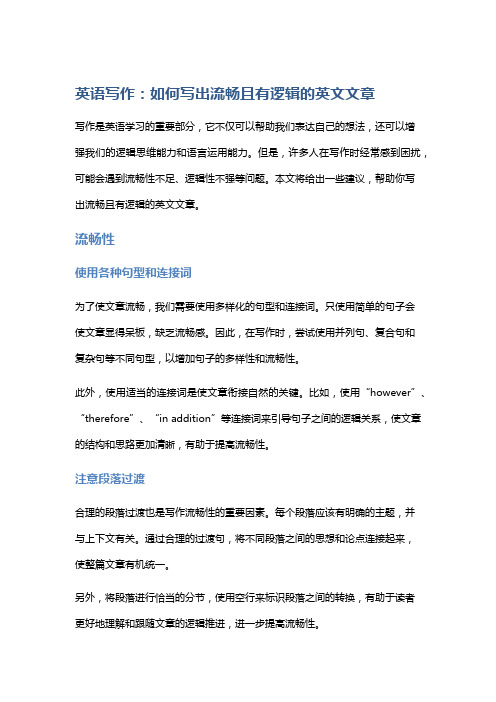
英语写作:如何写出流畅且有逻辑的英文文章写作是英语学习的重要部分,它不仅可以帮助我们表达自己的想法,还可以增强我们的逻辑思维能力和语言运用能力。
但是,许多人在写作时经常感到困扰,可能会遇到流畅性不足、逻辑性不强等问题。
本文将给出一些建议,帮助你写出流畅且有逻辑的英文文章。
流畅性使用各种句型和连接词为了使文章流畅,我们需要使用多样化的句型和连接词。
只使用简单的句子会使文章显得呆板,缺乏流畅感。
因此,在写作时,尝试使用并列句、复合句和复杂句等不同句型,以增加句子的多样性和流畅性。
此外,使用适当的连接词是使文章衔接自然的关键。
比如,使用“however”、“therefore”、“in addition”等连接词来引导句子之间的逻辑关系,使文章的结构和思路更加清晰,有助于提高流畅性。
注意段落过渡合理的段落过渡也是写作流畅性的重要因素。
每个段落应该有明确的主题,并与上下文有关。
通过合理的过渡句,将不同段落之间的思想和论点连接起来,使整篇文章有机统一。
另外,将段落进行恰当的分节,使用空行来标识段落之间的转换,有助于读者更好地理解和跟随文章的逻辑推进,进一步提高流畅性。
练习写作和阅读流畅的写作需要大量的练习和阅读。
通过写作练习,我们可以不断提高自己的写作技巧和表达能力,逐渐熟练运用各种句式和连接词。
同时,通过阅读优秀的英文文章,我们可以学习他人的写作技巧和结构安排,从而提升自己的写作水平。
逻辑性建立清晰的思维框架在写作之前,建立一个清晰的思维框架是非常重要的。
首先,明确自己的写作目的和主题。
其次,在开始写作之前,进行一些默写思考,列出自己的观点和论据。
这将有助于构建一个有逻辑性、连贯性的论证结构。
合理组织段落和句子在写作过程中,合理组织段落和句子也是保持逻辑性的关键。
每个段落应该有一个明确的主题,围绕这个主题展开相关论述。
句子之间也需要有明确的逻辑关系,避免出现断裂和不连贯的情况。
为了保持逻辑性,我们可以使用举例、引用权威观点、逻辑推理等方式来支撑自己的论点,并使用合适的过渡词来连接不同的观点和段落,使整篇文章逻辑清晰、有条不紊。
英语写作文的技巧

英语写作文的技巧英语写作文的技巧首先,审题,条理清楚保证不跑提示写作当中第一任务,第二个重要任务就是要做到条理清楚。
对于议论文来说,正反面要清楚,对于说明文来说条理要清楚,对于描述文来说,谁干什么要清楚。
写主题句主题句是确保不跑题的前提,只有不跑题才有可得及格分。
写主题句嘴保险的方法就是把中文提纲的各句译成英语。
问题阐述适当用被动替换主动,这样能更客观地反映事实。
一句话用不同的句式来表达为了加强同学们对语法知识在写作中的灵活应用尽量复杂作文中的句式长句采用的特殊语法包括:宾语从句+分词结构做插入语+分词作后置定语(issued)+被动语态+原因短语+定语从句。
保证作文符合字数要求的十二句作文法作文120-150个字,考生一般都希望作文达到字数而又不至于写得太多,因为写得太多一方面暴露自己语言上的弱点,另一方面又会占用过多的时间。
写得太多还易跑题,一个有效的方法就是十二句作文法。
怎样提高英语作文词汇量词汇不仅仅是我们学习英语的基础,更是写出英语作文的基础。
倘若你连最常见的单词或者是词组都会写错,那么恐怕在英语写作这块就很难获得高分。
语法语法是我们英语作文遣词造句的基础,主谓宾,主系表,各种从句,虚拟语气,大家应该有所了解,如果能够在写作中熟练的运用语法,想必你的作文会出彩许多。
当然,如果你并不能确定某种语法,比如某个从句怎么用之类的,那么就用简单的句子代替吧。
逻辑明确我们大多数人的英文写作毕竟不能像写中文作文一样运用自如,所以小编建议大家在写作的时候还是按照事情发展的顺序来写,这样自己写起来容易,老师改卷的时候也能比较清晰的知道你想表达什么。
考试的时候切忌突然有个想法,来个倒叙或者插叙,很容易把老师弄晕。
作文模板很多专家或者培训机构都为大家总结了一些英语写作模板,虽然可能有点千篇一律,但是至少不会出错。
建议大家可以学习几个比较好的作文模板,熟练的掌握他们一定能在写作时有所发挥,至少会比较有条理。
积累英语作文的提高其实和大家平时的积累息息相关。
如何在英文写作中运用恰当的解释和说明
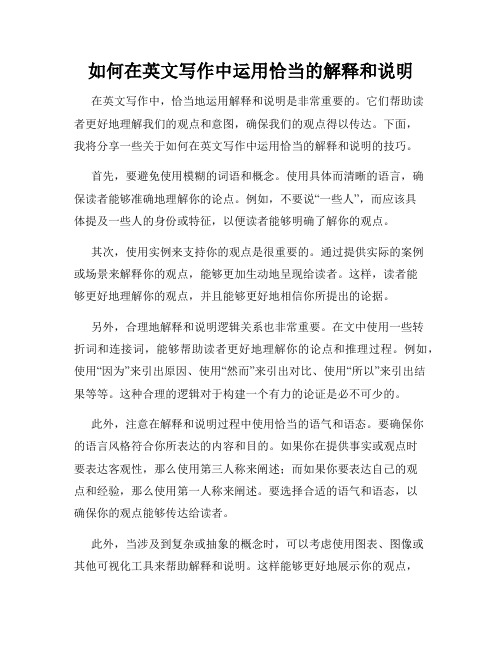
如何在英文写作中运用恰当的解释和说明在英文写作中,恰当地运用解释和说明是非常重要的。
它们帮助读者更好地理解我们的观点和意图,确保我们的观点得以传达。
下面,我将分享一些关于如何在英文写作中运用恰当的解释和说明的技巧。
首先,要避免使用模糊的词语和概念。
使用具体而清晰的语言,确保读者能够准确地理解你的论点。
例如,不要说“一些人”,而应该具体提及一些人的身份或特征,以便读者能够明确了解你的观点。
其次,使用实例来支持你的观点是很重要的。
通过提供实际的案例或场景来解释你的观点,能够更加生动地呈现给读者。
这样,读者能够更好地理解你的观点,并且能够更好地相信你所提出的论据。
另外,合理地解释和说明逻辑关系也非常重要。
在文中使用一些转折词和连接词,能够帮助读者更好地理解你的论点和推理过程。
例如,使用“因为”来引出原因、使用“然而”来引出对比、使用“所以”来引出结果等等。
这种合理的逻辑对于构建一个有力的论证是必不可少的。
此外,注意在解释和说明过程中使用恰当的语气和语态。
要确保你的语言风格符合你所表达的内容和目的。
如果你在提供事实或观点时要表达客观性,那么使用第三人称来阐述;而如果你要表达自己的观点和经验,那么使用第一人称来阐述。
要选择合适的语气和语态,以确保你的观点能够传达给读者。
此外,当涉及到复杂或抽象的概念时,可以考虑使用图表、图像或其他可视化工具来帮助解释和说明。
这样能够更好地展示你的观点,并更加直观地向读者传达信息。
同时,也可以利用段落和标题的分割来组织你的写作,让读者更容易跟随和理解你的观点。
最后,要不断练习和实践。
通过阅读和写作,我们可以不断提升自己在解释和说明上的技巧。
阅读优秀的英文写作作品,并注意作者是如何运用解释和说明的。
同时,自己多写多练习,反复尝试不同的解释和说明方法,提升自己的写作水平。
总之,在英文写作中,正确地运用解释和说明是非常重要的。
通过避免模糊词语、提供实例支持、合理解释逻辑关系、使用恰当的语气和语态、利用可视化工具辅助解释和不断练习,我们可以更好地传达我们的观点和意图,从而使我们的写作更具说服力和可读性。
高分高考英语作文的写作方法与技巧大全
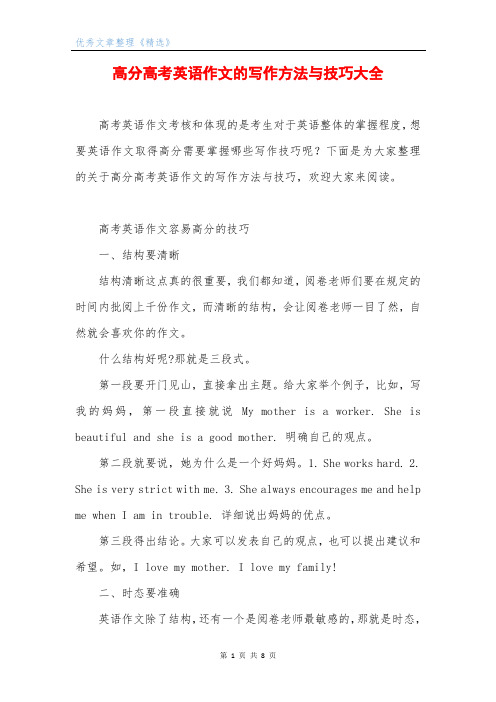
高分高考英语作文的写作方法与技巧大全高考英语作文考核和体现的是考生对于英语整体的掌握程度,想要英语作文取得高分需要掌握哪些写作技巧呢?下面是为大家整理的关于高分高考英语作文的写作方法与技巧,欢迎大家来阅读。
高考英语作文容易高分的技巧一、结构要清晰结构清晰这点真的很重要,我们都知道,阅卷老师们要在规定的时间内批阅上千份作文,而清晰的结构,会让阅卷老师一目了然,自然就会喜欢你的作文。
什么结构好呢?那就是三段式。
第一段要开门见山,直接拿出主题。
给大家举个例子,比如,写我的妈妈,第一段直接就说My mother is a worker. She is beautiful and she is a good mother. 明确自己的观点。
第二段就要说,她为什么是一个好妈妈。
1. She works hard. 2. She is very strict with me. 3. She always encourages me and help me when I am in trouble. 详细说出妈妈的优点。
第三段得出结论。
大家可以发表自己的观点,也可以提出建议和希望。
如,I love my mother. I love my family!二、时态要准确英语作文除了结构,还有一个是阅卷老师最敏感的,那就是时态,第1页共8页这也是一篇作文是否得高分的关键。
要明确文章的时态、同时人称要一致、数要一致、首尾要呼应。
再根据内容要求,现确定事情是过去已经发生还是未来即将发生,比如记叙一件事要用一般过去时;写经常发生的事或对人物的描写,要用一般现在时;对于未来的憧憬要用一般将来时;过去的事情对现在造成的影响或过去延续到现在的状况都用现在完成时。
一定不能乱用乱配。
三、短语运用要灵活同学们在写作文的时候,要尽量使用有把握的词,避免不必要的失分。
当然,定语从句、宾语从句等句型,在关键的时候用上一两个,会增添你文章的文采。
一些英文文章写作的技巧总结zz

一些英文文章写作的技巧总结zzIntroduction:Writing a compelling and well-crafted article in English requires a combination of creativity, language proficiency, and strategic thinking. Whether you are a student, a professional, or simply someone who wants to improve their writing skills, this guide will provide you with essential tips to enhance your English article writing abilities. From understanding the target audience to structuring your ideas effectively, here are some invaluable techniques to help you excel in the art of writing articles.I. Choose a Captivating Topic:The first step in writing a compelling article is selecting an engaging topic that appeals to your target audience. Consider current trends, relevant issues, or subjects of personal interest. The key is to choose something that will captivate and resonate with your readers.II. Conduct Thorough Research:Once you have decided on a topic, conduct thorough research to gather information and supporting evidence. Utilize reliable sources such as scholarly articles, books, reputable websites, and interviews with experts. Remember to take notes and carefully organize your research materials to streamline the writing process.III. Define Your Objective:Before starting the actual writing process, clearly define the objective of your article. Determine whether you want to inform, persuade, or entertain your readers. This will help you maintain focus and structure your content accordingly.IV. Craft a Compelling Introduction:The introduction forms the foundation of your article. It should grab the reader's attention, provide a concise overview of the topic, and present your thesis statement. Consider using a captivating anecdote, a thought-provoking question, or a relevant statistic to engage your readers from the beginning.V. Structure Your Content:Organizing your ideas in a logical and coherent manner is crucial for article writing. Consider using the classic structure of an introduction, body paragraphs, and a conclusion. Each paragraph in the body should contain a single main idea supported by evidence, examples, or expert opinions. Use transitional words and phrases to ensure smooth flow and cohesion between paragraphs.VI. Use Clear and Concise Language:The hallmark of a well-written article is the use of clear and concise language. Avoid unnecessary jargon, complex sentence structures, and excessive wordiness. Instead, strive for simplicity and clarity, making your content more accessible to a wider audience.VII. Employ Persuasive Techniques:If your objective is to persuade readers, employ persuasive techniques to strengthen your arguments. This may include using rhetorical questions, appeals to emotion, relevant analogies, or credible statistics. However, be mindful not to manipulate or mislead your audience; maintain honesty and integrity in your writing.VIII. Engage with the Reader:To keep your readers engaged, incorporate elements that encourage interaction. This could involve asking questions, providing opportunities for reflection, or incorporating relevant personal anecdotes. By establishing a connection with your readers, you establish trust and enhance the overall reader experience.IX. Revise and Edit:A vital step in the writing process is revising and editing your article. Proofread for grammar, punctuation, and spelling errors. Check the flow of ideas, coherence, and overall readability. Consider seeking feedback from peers, instructors, or professional editors for a fresh perspective.X. Conclusion:Crafting a high-quality English article requires practice, dedication, and attention to detail. By employing effective techniques such as selecting captivating topics, conducting thorough research, and fine-tuning your writing skills, you can create articlesthat are informative, persuasive, and engaging. Remember, mastering the art of article writing takes time, but with persistence and the right tools, you can become a proficient writer capable of captivating and inspiring your readers.。
英文写作中的段落结构与过渡技巧

英文写作中的段落结构与过渡技巧在英语写作中,良好的段落结构和流畅的过渡是写作的关键。
一个段落应该有明确的主题,并且从一个思想到另一个思想之间应该有清晰的连接。
以下是一些在英文写作中使用的段落结构和过渡技巧。
1. 开篇引出主题一个好的段落应该以一个明确的主题句开始,这句话应该简洁明了地概括出该段落要讨论的主题。
例如,如果你想写一篇关于科技对现代社会的影响的文章,你可以在第一个段落中写:“科技在现代社会中扮演着至关重要的角色。
” 这句话将引出整个段落的主题。
2. 提供支持性论据接下来的几个句子应该提供支持性的论据来支持你的主题句。
你可以用现实生活中的例子、调查数据或其他可信来源的信息来证明你的观点。
例如,如果你正在讨论科技对教育的影响,你可以提供一些研究结果,表明使用科技设备在课堂上能够提高学生的学习成绩。
3. 引出下一个论点在段落的结尾,你应该引出下一个要讨论的论点。
这可以通过一些类似于“此外”、“另外”、“除此之外”之类的过渡词来实现。
这个过渡句将帮助你平稳地过渡到下一个段落。
例如,在讨论科技对社交关系的影响之后,你可以写:“除了对教育的影响,科技也在社交关系中扮演着重要的角色。
”4. 过渡词的使用过渡词在段落之间的过渡中起着重要的作用。
它们帮助连接一个段落的思想到下一个段落的思想,使整篇文章更具连贯性。
例如,当你结束一个段落时,你可以使用过渡词“同时”或“然而”来引出下一个段落的思想。
5. 反思和总结段落的结尾非常重要,它应该反思和总结整个段落的内容,并为下一个段落提供一个引子。
这将使读者更容易理解你的观点并跟上你的思路。
例如,在讨论科技对社交关系的影响之后,你可以写:“因此,虽然科技在许多方面为我们带来了便利,但它也对我们的社交关系产生了消极的影响。
”在英文写作中,正确地构建段落结构和使用适当的过渡词对于传达你的思想和保持读者的兴趣非常重要。
通过遵循以上提到的几个技巧,你将能够写出更好的英文段落,使你的写作更加流畅和有条理。
英文写作技巧避免使用模糊和不准确的词语

英文写作技巧避免使用模糊和不准确的词语在英文写作中,避免使用模糊和不准确的词语是非常关键的。
准确清晰的表达可以帮助读者更好地理解作者的意图,并且更准确地传达信息。
本文将介绍一些应对这个问题的有效技巧。
首先,要避免使用模糊的词语,作者需要确保自己的表达足够具体和明确。
一个常见的例子是使用形容词“好的”(good)来描述事物。
这个词过于广泛,缺乏具体信息,使得读者无法准确地理解作者的意思。
相比之下,使用更具体的形容词,如“出色的”(excellent)、“令人满意的”(satisfactory)等,可以为读者提供更多细节,使得表达更具体。
其次,要避免使用不准确的词语,作者需要确保所使用的词与自己的意图相符。
一个常见的例子是使用动词“做”(do)。
虽然“做”是一个非常通用的动词,但它的使用范围过于广泛,缺乏具体意义。
为了更准确地传达信息,作者应该尽量使用更具体的动词,如“制作”(create)、“完成”(accomplish)等。
这样可以使得文章更加具体明确,让读者更容易理解。
此外,使用适当的形容词和副词也是避免模糊和不准确的词语的有效方法。
形容词和副词可以为句子添加更多的信息,使得句子更具体且更丰富。
例如,使用“非常快速地”(very fast)而不是“快”(fast)可以使得读者更准确地理解作者要表达的速度。
再者,要尽量避免使用含混的词语。
有时候,一些词语的含义可能因为语境的变化而有所不同。
为了避免混淆,作者需要特别注意词语的准确用法。
在写作过程中,可以参考词典或其他语言资源以确保所使用的词语具有准确的含义。
另外,对于一些具有多种解释的词语,可以在使用时给出明确的定义,以避免引起误解。
最后,积累更多的词汇也是避免使用模糊和不准确词语的重要方法。
拓展词汇量可以帮助作者更好地选择准确和具体的词语,从而提高文章的准确性和清晰度。
通过阅读和学习,积累更多的词汇可以让作者的写作更加丰富有力。
综上所述,避免使用模糊和不准确的词语在英文写作中至关重要。
英文写作中的观点阐述技巧

英文写作中的观点阐述技巧在英文写作中,观点阐述是一个重要的技巧,它可以帮助作者清晰、有力地表达自己的观点和意见。
本文将分享一些在英文写作中常用的观点阐述技巧,帮助读者提升英文写作的能力。
1. 使用明确的观点陈述在英文写作中,观点的表达应该要明确、精准。
不要拖泥带水或含糊其辞。
可以使用一些诸如 "I believe"、"In my opinion"、"It is clear that"等短语来直接陈述观点,使读者能够准确理解你的立场。
例如:I believe that technology has greatly improved our lives in various aspects.(我相信科技在许多方面极大地改善了我们的生活。
)2. 引用权威观点在论述观点时,引用权威人士的观点或相关研究结果可以提升你的文章信服力。
这不仅向读者展示你的观点有依据,而且向他们展示你已经考虑到了其他人的看法和观点。
例如:According to a study conducted by Harvard University, regular exercise not only improves physical fitness, but also enhances cognitive function.(根据哈佛大学的一项研究显示,定期运动不仅可以提高身体健康,还能增强认知功能。
)3. 使用实例和案例实例和案例是有效支持观点的方法,它们能够具体地展示你的观点在现实生活中的应用和效果。
通过提供真实的例子,读者更容易理解你的观点,并且更容易接受它。
例如:The city of Copenhagen in Denmark is a great example of sustainable urban planning. Through the implementation of bike-friendly infrastructure and effective waste management systems, Copenhagen has successfully reduced carbon emissions and improved the overall well-being of its residents.(丹麦的哥本哈根市就是可持续城市规划的典范。
英文写作中的引文和注释技巧

英文写作中的引文和注释技巧引文和注释是英文写作中非常重要的技巧,它们能够增强文章的可信度和可读性。
在写作过程中,正确地使用引文和注释可以帮助我们准确引述他人的观点,有效地支持自己的论述,并且避免抄袭的问题。
以下是一些引文和注释的技巧,希望对大家写作有所帮助。
一、引文的使用技巧在引用书籍、文章或其他资料时,我们需要用引文来标注出原作者的观点或论述。
以下是一些引文的使用技巧:1. 引文的引入方式:直接引用或间接引用。
直接引用是将原句完整地引入文章中,需要使用引号包围,并注明原作者的姓名和出处。
间接引用是将原作者的观点或论述用自己的话简洁地表达出来,同样需要注明出处。
2. 引文的格式:引文需要按照特定格式来书写,根据不同的引文格式,参考文献的书写方式也有所不同。
常见的引文格式有APA、MLA和Chicago style等。
在进行学术写作时,我们需要根据要求使用相应的引文格式,并适当标注页码等信息。
3. 引文的长度和使用频率:在引用他人观点时,要适度使用引文,并注意引文的长度和使用频率。
过多的引文会使文章显得负重感过重,而过少的引文则无法充分支持自己的观点。
在选择引文时,应选择那些能够最有效地支持自己的论述、有代表性的观点。
二、注释的技巧注释是对引用资料进行解释、补充和说明的文字。
以下是一些注释的技巧:1. 注释的内容:注释应该对引文进行解释、补充和说明。
可以解释作者的观点,说明作者的研究方法,补充一些相关的背景知识等。
注释的内容需要与文章的主题密切相关,帮助读者理解和思考。
2. 注释的位置:注释可以放在引文之后,也可以放在引文所在段落的结尾。
放在引文之后可以更清晰地表明注释的目的,放在段落结尾可以更好地与作者的观点结合起来。
3. 注释的书写方式:注释的书写方式可以根据需要灵活运用。
可以使用脚注或尾注的形式进行注释,也可以在文章的正文中进行注释。
无论采用哪种方式,都需要保持注释内容的逻辑清晰,避免过于冗长或过于简洁。
英文写作常用句型分类总结5篇
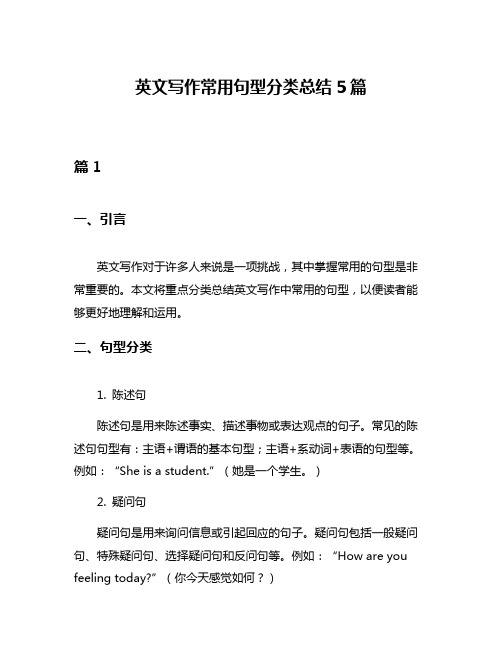
英文写作常用句型分类总结5篇篇1一、引言英文写作对于许多人来说是一项挑战,其中掌握常用的句型是非常重要的。
本文将重点分类总结英文写作中常用的句型,以便读者能够更好地理解和运用。
二、句型分类1. 陈述句陈述句是用来陈述事实、描述事物或表达观点的句子。
常见的陈述句句型有:主语+谓语的基本句型;主语+系动词+表语的句型等。
例如:“She is a student.”(她是一个学生。
)2. 疑问句疑问句是用来询问信息或引起回应的句子。
疑问句包括一般疑问句、特殊疑问句、选择疑问句和反问句等。
例如:“How are you feeling today?”(你今天感觉如何?)3. 感叹句感叹句用于表达强烈的情感或情绪。
常见的感叹句句型有:What a/an + 形容词+ 可数名词单数;How + 形容词+ 动词原形等。
例如:“What a beautiful day!”(多么美好的一天!)4. 祈使句祈使句用于表达请求、命令、建议或警告。
祈使句的常见句型包括:动词原形开头;Let's 开头等。
例如:“Please close the door.”(请关门。
)5. 并列句并列句由两个或多个简单句构成,通过并列连词(如and, but, or 等)连接。
例如:“I like coffee, but she prefers tea.”(我喜欢咖啡,但她喜欢茶。
)6. 复合句复合句包含一个主句和一个或多个从句。
常见的引导词有that, which, who等。
例如:“I know that she is a talented singer.”(我知道她是一个有天赋的歌手。
)三、常用句型举例1. 主语+谓语的基本句型:John sings beautifully.(约翰唱得很美。
)2. 主语+系动词+表语的句型:The weather is nice today.(今天天气很好。
)3. What a/an + 形容词+ 可数名词单数的感叹句:What a beautiful painting!(多么美丽的画啊!)4. How + 形容词+ 动词原形的感叹句:How fast he runs!(他跑得真快!)5. 并列句:She likes coffee, but her friend prefers tea.(她喜欢咖啡,但她的朋友更喜欢茶。
一些英文文章写作技巧
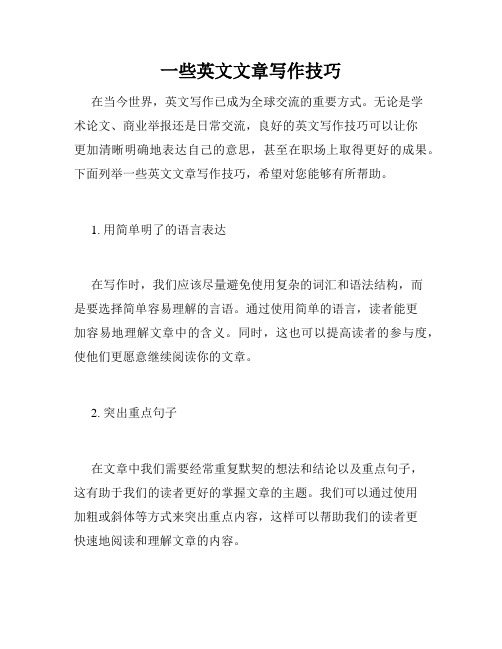
一些英文文章写作技巧在当今世界,英文写作已成为全球交流的重要方式。
无论是学术论文、商业举报还是日常交流,良好的英文写作技巧可以让你更加清晰明确地表达自己的意思,甚至在职场上取得更好的成果。
下面列举一些英文文章写作技巧,希望对您能够有所帮助。
1. 用简单明了的语言表达在写作时,我们应该尽量避免使用复杂的词汇和语法结构,而是要选择简单容易理解的言语。
通过使用简单的语言,读者能更加容易地理解文章中的含义。
同时,这也可以提高读者的参与度,使他们更愿意继续阅读你的文章。
2. 突出重点句子在文章中我们需要经常重复默契的想法和结论以及重点句子,这有助于我们的读者更好的掌握文章的主题。
我们可以通过使用加粗或斜体等方式来突出重点内容,这样可以帮助我们的读者更快速地阅读和理解文章的内容。
3. 调整语法结构来增加文章流畅度有时候我们会发现,文章中句子结构过于固定或单调,这会使得文章显得乏味和无趣。
因此,我们需要学会灵活运用语法结构,使用不同的词汇、句型和长短,来使文章更加生动有趣。
4. 使用适当的连接词连接词可以使文章的逻辑结构更加紧密,使得读者更易于理解文章的含义。
在写作过程中,我们可以使用适当的连接词和词组来使文章的逻辑更加清晰,这样读者就可以轻易地理解文章的内涵和结论。
5. 用具体的例子和实证来支撑观点在写作中,我们可以通过使用具体的例子和实证来支持我们的观点。
这样,读者可以更好地理解文章中的含义和论点,并且在理解后会产生更强的信心和认同。
通过使用合理的、具有代表性的例子,我们能够使读者更加清晰地理解我们的观点。
总之,英文写作是一项技能,需要不断的发掘和提升。
以上只是其中一些技巧和方法,更好的口才和技巧取决于我们的实践和不断的总结。
如果您学会了以上的技巧,并在写作过程中不断尝试和实践,相信在英文写作上您一定能够有更好的表现!。
论文写作中的英文写作技巧
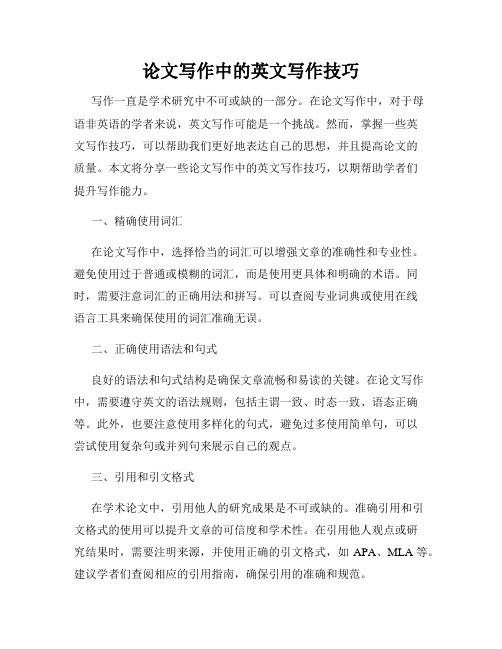
论文写作中的英文写作技巧写作一直是学术研究中不可或缺的一部分。
在论文写作中,对于母语非英语的学者来说,英文写作可能是一个挑战。
然而,掌握一些英文写作技巧,可以帮助我们更好地表达自己的思想,并且提高论文的质量。
本文将分享一些论文写作中的英文写作技巧,以期帮助学者们提升写作能力。
一、精确使用词汇在论文写作中,选择恰当的词汇可以增强文章的准确性和专业性。
避免使用过于普通或模糊的词汇,而是使用更具体和明确的术语。
同时,需要注意词汇的正确用法和拼写。
可以查阅专业词典或使用在线语言工具来确保使用的词汇准确无误。
二、正确使用语法和句式良好的语法和句式结构是确保文章流畅和易读的关键。
在论文写作中,需要遵守英文的语法规则,包括主谓一致、时态一致、语态正确等。
此外,也要注意使用多样化的句式,避免过多使用简单句,可以尝试使用复杂句或并列句来展示自己的观点。
三、引用和引文格式在学术论文中,引用他人的研究成果是不可或缺的。
准确引用和引文格式的使用可以提升文章的可信度和学术性。
在引用他人观点或研究结果时,需要注明来源,并使用正确的引文格式,如APA、MLA等。
建议学者们查阅相应的引用指南,确保引用的准确和规范。
四、结构清晰、段落过渡自然良好的结构可以使文章逻辑清晰且易于理解。
在论文写作中,可以采用传统的导言、正文和结论的结构,或是根据自己的需要选择其他适当的结构。
在每个段落中,要确保句子之间的过渡自然,保持段落之间的连贯性。
使用适当的过渡词可以帮助读者理解文章的脉络和思路。
五、阅读和修改写完论文后,不要忘了进行仔细的阅读和修改。
首先,阅读一遍论文,检查语法错误、句子不通顺或不准确的表达。
其次,检查论文的逻辑性和连贯性,确保每段的内容围绕主题展开,并且段落之间有明确的过渡。
此外,还可以请同行或专业编辑对论文进行评审,以获得更深入的意见和建议。
综上所述,论文写作中的英文写作技巧是非常重要的。
精确使用词汇、正确使用语法和句式、引用和引文格式的准确性、结构清晰和段落过渡自然以及阅读和修改都是提高论文写作质量的关键步骤。
- 1、下载文档前请自行甄别文档内容的完整性,平台不提供额外的编辑、内容补充、找答案等附加服务。
- 2、"仅部分预览"的文档,不可在线预览部分如存在完整性等问题,可反馈申请退款(可完整预览的文档不适用该条件!)。
- 3、如文档侵犯您的权益,请联系客服反馈,我们会尽快为您处理(人工客服工作时间:9:00-18:30)。
一些英文写作的语言技巧总结一些常见的英文文章语言技巧a)如何指出当前研究的不足以及有目的地引导出自己的研究的重要性。
通常在叙述了前人成果之后,用However来引导不足,比如However, little information..little attention...little work...little datalittle researchor few studiesfew investigations...few researchers...few attempts...or nonone of these studieshas (have) been lessdone on ...focused onattempted toconductedinvestigatedstudied(with respect to)Previous research (studies, records) has (have)failed to considerignoredmisinterpretedneglected tooverestimated, underestimatedmisleadedthus, these previus results areinconclisive, misleading, unsatisfactory, questionable, controversial..Uncertainties (discrepancies) still exist ...这种引导一般提出一种新方法,或者一种新方向。
如果研究的方法以及方向和前人一样,可以通过下面的方式强调自己工作的作用:However, data is still scarcerareless accuratethere is still dearth ofWe need toaim tohave toprovide more documentsdatarecordsstudiesincrease the datasetFurther studies are still necessary...essential...为了强调自己研究的重要性,一般还要在However之前介绍自己研究问题的反方面,另一方面等等。
比如:1)时间问题如果你研究的问题时间上比较新,你就可以大量提及对时间较老的问题的研究及重要性,然后说(However),对时间尺度比较新的问题研究不足2)物性及研究手段问题如果你要应用一种新手段或者研究方向,你可以提出当前比较流行的方法以及物质性质,然后说对你所研究的方向和方法,研究甚少。
3)研究区域问题首先总结相邻区域或者其它区域的研究,然后强调这一区域研究不足4)不确定性虽然前人对这一问题研究很多,但是目前有两种或者更多种的观点,这种uncertanties, ambiguities,值得进一步澄清5)提出自己的假设来验证如果自己的研究完全是新的,没有前人的工作进行对比,在这种情况下,你可以自信地说,根据提出的过程,存在这种可能的结果,本文就是要证实这种结果。
We aim to test the feasibility (reliability) of the ...It is hoped that the qutestion will be resolved (fall away) with our proposedmethod (approach).b) 提出自己的观点We aim toThis paper reports onprovides resultsextends the method..focus onThe purpose of this paper is toFurthermore, Moreover, In addition,, we will also discuss...c) 圈定自己的研究范围前言的另外一个作用就是告诉读者包括(reviewer)你的文章主要研究内容。
如果处理不好,reviewer会提出严厉的建议,比如你没有考虑某种可能性,某种研究手段等等。
为了减少这种争论,在前言的结尾你就要明确提出本文研究的范围:1)时间尺度问题如果你的问题涉及比较长的时序,你可以明确地提出本文只关心这一时间范围的问题。
We preliminarily focus on the older (younger)...或者有两种时间尺度的问题(long-term and short term),你可以说两者都重要,但是本文只涉及其中一种2) 研究区域的问题和时间问题一样,明确提出你只关心这一地区d) 最后的原场在前言的最后,还可以总结性地提出,这一研究对其它研究的帮助。
或者说,further studies on ... will be summarized in our next study (or elsewhere)总之,其目的就是让读者把思路集中到你要讨论的问题上来。
减少争论(arguments).关于词汇以及常用结构,要经常总结,多读多模仿才能融会贯通。
以上是常见的语言结构,不算抄袭。
怎样提出观点在提出自己的观点时,采取什么样的策略很重要。
不合适的句子通常会遭到reviewer 的置疑。
1)如果观点不是这篇文章最新提出的,通常要用We confirm that...2)对于自己很自信的观点,可用We believe that...3)在更通常的情况下,由数据推断出一定的结论,用,Results indicate, infer, suggest, imply that...4) 在及其特别的情况才可以用We put forward (discover, observe..) .. "for the first time".来强调自己的创新。
5) 如果自己对所提出的观点不完全肯定,可用We tentatively put forward (interrprete this to..) Or The results may be due to (caused by) attributed to rsulted from..Or This is probably a consequence ofIt seems that .. can account for (interpret) this..Or It is pisible that it stem from...要注意这些结构要合理搭配。
如果通篇是类型1)和5),那这篇文章的意义就大打折扣。
如果全是2),肯定会遭到置疑。
所以要仔细分析自己成果的创新性以及可信度。
连接词与逻辑写英文论文最常见的一个毛病就是文章的逻辑不清楚。
解决的方法有:1)句子上下要有连贯,不能让句子之间独立常见的连接词语有, However, also, in addition,consequently, afterwards, moreover, Furthermore,further, although, unlike, in contrast, Similarly,Unfortunately, alternatively, parallel results,In order to, despite, For example, Compared withother results, thus, therefore...用好这些连接词,能够使观点表达得有层次,更加明确。
比如,如果叙述有时间顺序的事件或者文献,最早的文献可用AA advocated it for the first time.接下来,可用Then BB further demonstrated that..再接下来,可用Afterwards, CC..如果还有,可用More recent studies by DD..如果叙述两种观点,要把它们截然分开AA pput forward that...In contrast, BB believeor Unlike AA, BB suggestor On the contrary (表明前面的观点错误,如果只是表明两种对立的观点,用in contrast),BB..如果两种观点相近,可用AA suggestSimilarily, alternatively, BB..Or Also, BBor BB allso does ..表示因果或者前后关系,可用Consequently, therefore, as a result,表明递进关系,可用furthermore, further, moreover, in addition,当写完一段英文,最好首先检查一下是否较好地应用了这些连接词。
2) 段落的整体逻辑经常我们要叙述一个问题的几个方面。
这种情况下,一定要注意逻辑结构。
首先第一段要明确告诉读者你要讨论几个部份...Therefore, there are three aspects of this problen have to be addressed.The first questuon involves...The second problem relates toThe thrid aspect deals with...上面的例子可以清晰地把观点逐层叙述。
Or, 可以直接用First, Second, Third...Finally,..当然,Furthermore, in addition等可以用来补充说明。
3) 讨论部份的整体结构小标题是比较好的方法把要讨论的问题分为几个片段。
一般第一个片段指出文章最为重要的数据与结论。
补充说明的部份可以放在最后一个片段。
一定要明白文章的读者会分为多个档次。
文章除了本专业的专业人士读懂以外,一定要想办法能让更多的外专业人读懂。
所以可以把讨论部份分为两部份,一部份提出观点,另一部份详细介绍过程以及论述的依据。
这样专业外的人士可以了解文章的主要观点,比较专业的讨论他可以把它当成黑箱子,而这一部份本专业人士可以进一步研究。
为了使文章清楚,第一次提出概念时,最好加以个括弧,给出较为详细的解释。
如果文章用了很多的Abbreviation, 两种方法加以解决1) 在文章最好加上个Appendix,把所有Abreviation列表2) 在不同的页面上,不时地给出Abbreciation的含义,用来提醒读者。
总之,写文章的目的是要让读者读懂,读得清晰,并且采取各种措施方便于读者。
一定要注意绝对不能全面否定前人的成果,即使在你看来前人的结论完全不对。
这是前人工作最起码的尊重,英文叫做给别人的工作credits. 所以文章不要出现非常negative的评价,比如Their results are wrong, very questionable, have no commensence, etc. 遇到这类情况,可以婉转地提出:Their studies may be more reasonable if they had considered this situation. Their results could be better convinced if they ...Or Their conclusion may remain some uncertanties.讨论部份还包括什么内容?1. 主要数据特征的总结2. 主要结论以及与前人观点的对比3. 本文的不足第三点,在一般作者看来不可取。
